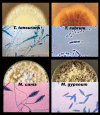A foot in the door for dermatophyte research
- PMID: 22479177
- PMCID: PMC3315479
- DOI: 10.1371/journal.ppat.1002564
A foot in the door for dermatophyte research
Conflict of interest statement
The authors have declared that no competing interests exist.
Figures



References
-
- Seebacher C, Bouchara JP, Mignon B. Updates on the epidemiology of dermatophyte infections. Mycopathologia. 2008;166:335–352. - PubMed
-
- Havlickova B, Czaika VA, Friedrich M. Epidemiological trends in skin mycoses worldwide. Mycoses. 2008;51(Suppl 4):2–15. - PubMed
-
- World Health Organization. Epidemiology and management of common skin diseases in children in developing countries. Department of Child and Adolescent Health and Development. 2005. 54 WHO reference number WHO/FCH/CAH/05.12.
-
- Abdel-Rahman SM, Farrand N, Schuenemann E, Stering TK, Preuett B, et al. The prevalence of infections with Trichophyton tonsurans in schoolchildren: the CAPITIS study. Pediatrics. 2010;125:966–973. - PubMed
Publication types
MeSH terms
Substances
Grants and funding
LinkOut - more resources
Full Text Sources

